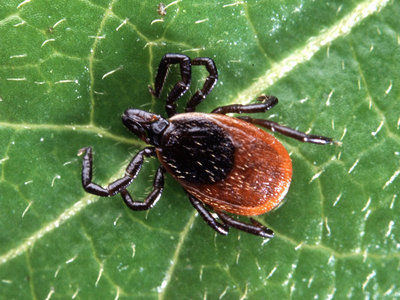
What is one to do after being bitten by a tick?
Ticks are tiny arachnids closely related to mites. There are many types of ticks in the United States, many of which are capable of transmitting infections. The risk of developing any of those infections depends on the type of tick, the geographical location, the season of the year and, especially in the case of Lyme disease, how long the tick was attached to the skin.
The risk of illness depends a great deal on where one lives or visits. People in a few areas of the United States are at a high risk of Lyme disease, especially in the mid-Atlantic, upper Midwestern states and several counties in northwestern California.
In Santa Cruz County, it is reported that 5 percent of ticks carry the Lyme bacteria, with the area around Nicene Marks State Park in Aptos having a somewhat higher concentration of Lyme risk.
Although many people worry after being bitten by a tick, the risk of acquiring an infection is quite low, even if the tick has been attached to the skin, has fed and actually carries the infectious Lyme germ.
Neither the tick’s body nor its head burrows into the skin. Instead, the tick attaches by its mouthparts. An infected tick can transmit an infection only after it has been attached, taken blood from its host and fed for 24 to 48 hours. An unattached, non-engorged tick can not have transmitted an infection.
There are an untold number of popular methods for removing an attached tick, including burning the tick, applying nail polish to its body, smothering it with oil and twisting it either clockwise or counterclockwise, and so on. These methods are ineffective and may cause the tick to inject more of its infected fluids into its host, thus increasing the chance of infection.
The proper method of removing a tick is to use a fine pair of tweezers and grasp the tick as close to the skin as possible. Pull it straight out, gently but firmly, without jerking or twisting. After removing the tick, wash your hands and the skin around the bite thoroughly with soap and water.
If, after removal, you see anything remaining in the skin, this represents tiny mouthparts of the tick. It is not the tick’s “head,” and it cannot increase the risk of transmission of Lyme disease once the tick body is removed.
There is some controversy concerning what to do if the tick’s mouthparts have remained in the skin. Technically, these mouthparts are no worse than having a small wooden splinter in your skin. Don’t waste your time trying to pull them out with a pair of tweezers, since the mouthparts are stuck together with small barbs and actually glued together.
If you’re brave, you can attempt to remove them after cleaning the area with alcohol, using a sterilized needle to tease them out as you would a splinter. If the bite was in a noncosmetic (unseen) area, the mouthparts can be left alone and will most likely fall out over time; but there is the chance they won’t and may leave a small bump. If the bite site is in a noticeable part of the body and you do not wish to deal with it, you can visit your doctor and have them removed.
Once the tick has been removed, it can be sent to a laboratory to have it tested for Lyme disease, but the tests are not perfect and may give either a false positive or false negative result, which can lead to confusion as to how to proceed with further treatment. Furthermore, it’s possible to have been infected by another tick of which you were never aware, and if symptoms should arise after the known tick tests negative, there’s a risk you might not seek treatment, believing you are not infected.
Therefore, it is more important to learn to recognize the symptoms of Lyme disease, because they might show up even after a negative test result. Anyone who exhibits Lyme symptoms needs to seek immediate evaluation and treatment from a doctor. I will discuss more about signs and symptoms of Lyme disease in a future column.
Terry Hollenbeck, M.D., is an urgent-care physician at Palo Alto Medical Foundation Santa Cruz in Scotts Valley. A doctor with 36 years’ experience, he invites readers to view his previous columns at his website, valleydoctor.wordpress.com. Information in this column is not intended to replace advice from your own health care professional. For any medical concern, consult your own doctor.












